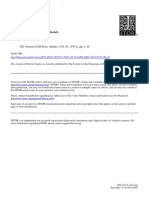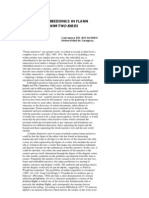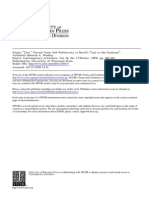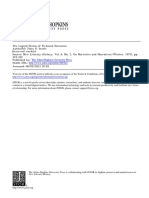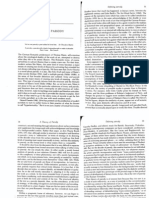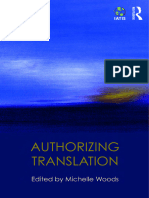Img 0009
Img 0009
Uploaded by
Bianca DarieCopyright:
Available Formats
Img 0009
Img 0009
Uploaded by
Bianca DarieOriginal Description:
Original Title
Copyright
Available Formats
Share this document
Did you find this document useful?
Is this content inappropriate?
Copyright:
Available Formats
Img 0009
Img 0009
Uploaded by
Bianca DarieCopyright:
Available Formats
3
$uccessful reference "does not depend upon ihe truth of the description contained in the refening expression"
(Lyons, 1977: 161). lt rather depends "on the hearefs identifying, for the purpose 0f understanding the cunent
linguistic message, fhe speaker"s interded refererrt, on the basis of the refening expression used" (Brown & Yule,
1983: 205; emphasis added). Example (context: restaurant, waitertalking to his replacement):
The ham sandnictt is sitting attable 20.
He is sitting attable 20.
(ln either case, the hearefs knowledge of the specific relation between the 'ham sandwich' and the 'customer at
table 20' is assumed. We may, of course, inferthat reference depends on the decoders'regesentations.)
The following example quoted by Brown & Yule (1983: 214) is illustrative of the way in which the nature of
gedicatian and the cvnversatianal context as well as the co4ert influence the decoder's (i.e., the hearefs or
readefs) representations of discourse entities. (Discuss the words in italics in terms of conecUsuccessful
reference)
Turbaned ladies hobbled towards the cathedral, scuffing the dust with feet too splayed and calloused to
admit the wearing of shoes. Their cottons were painted with leaves and lions and portraits of military
dictators. They hauled themselves into the teak pews ... lSix interuening paragraphs describe others
aniving at the cathedral and the beginning of the service./
At the Credo, the ladies sighed, heaved theirthighs and got to their feet. Leffers,lions, /eayres and military
dictators rustled and recomposed themselves.
(Bruce Chatwin, The Viceroy of Anidah, Picador, 1982:1415)
4. Reference and Fictionalrty (Og[!gnA!- and very interesting! Particularly if you like literature...)
The queslion of what - if anything - literary works refer to has repeatedly been asked ever since antiquity (at this
point Plato and Arislotle would deserve special attention). Two extreme answers can be suggested by the
following examples: (a) in the sixth century B.C. the Athenian legislator Solon complained of the many lies told by
poets; (b) in his Apology for Poetry (1598), Sidney answers the accusation that poets are liars by arguing: "Now,
for the poet, he nothing affirms, and so therefore never lieth I ... / And therefore, though he recount things not true,
yet because he telleth them not fortrue, he lieth not ..."
It is not hald to demonstrate that literary fidion and lying are essentially different. Fiction is a significant
component of our everyday lives. We read comic slrips in magazines or read novels, we play games with our
children, watch TV, share jokes with our mates ... All these activities "involve mutual manipulation of fictional
conslructs according to central rules and conventions" (Hawthom, 1987, p. 95). They involve complex mediations
between fiction and reality and between our cultural reality and our object reality.
To realize that a literary work has no simplistic or mechanistic relationship to extra-textual reality "is not necesarily
to accept that the work contains no reference to the non-literary world" (Hawthom 1987, p.96). In order to
understand a work, any reader brings certain knowledge from the world. He brings the knowledge of a language,
and hence of a culture and of a part of the world. Central to literary reference is regesenfafion, which "never
works on a one-to-one basis: it is either partial, taking the part for the whole, or involves more complex processes
such as condensation and displacement which Freud traced in dream representation. lt is for this reason that a
single item in a piece of a representation may involve reference on a range of different levels. Where
representation is partial it has involved choice, and this is in part a commentary on the reality it selectively
imitated" (Hawthom, 1987, p. 97).
Three aspects are worth mentioning:
1) Literary works, in some way or another, do reflect extra'linguistic reality, but the linguistic signs which are used
are not meant to be refened directly to past or present contextual factors and cireumstances by the addressee,
that is, the reader. Fictional texts are situationally autonomous. The writer presupposes the reader to understand
the fictional text in its own intemal fields of reference, which creates fields of fictitious mnlrlrtual reference. The
reade/s understanding of the text, which is both hislorically and cutturally determined, depends on how he is able
to link the text-intemal mdel of the world to his own mdel of the world of the past (before now) and now (i.e.
when he is decoding the text)" (Werlich, 1983, p. 44). Certain tent form variants develop combinations of fad and
fiction that lead to such works as documentary novelslplays, historical navels/plays, ghast-wttten autobiographies.
(fhat is why Truman Capote's ln Cold B/ood has been called a faction, i.e., fact + fiction.)
2) Pragmatically speaking, during the reading experience the reader frequently oscillates between immersion in
the world of the work and consciousness of the text as text. We are, of cource, able to 'live' in the fiditious world
You might also like
- Dolezel Lubomir - Truth and Authenticity in NarrativeDocument20 pagesDolezel Lubomir - Truth and Authenticity in NarrativeISABELLA RIVA LA SERNANo ratings yet
- ADKINS (Homeric Values and Homeric Society)Document15 pagesADKINS (Homeric Values and Homeric Society)malena_arce_2No ratings yet
- Narratology. Lecture 1Document5 pagesNarratology. Lecture 1Iulia OnofreiNo ratings yet
- Literature and RealityDocument5 pagesLiterature and RealityAndreea Ungureanu100% (1)
- Intertextuality: III. Types of IntertextualityDocument6 pagesIntertextuality: III. Types of IntertextualityEl-el Galindo Mascariňas100% (1)
- Introduction To NarratologyDocument21 pagesIntroduction To NarratologyMirEllaEllaNo ratings yet
- Img 0010Document1 pageImg 0010Bianca DarieNo ratings yet
- Intertextuality of TextDocument5 pagesIntertextuality of TextMuhammad Akram Mas'udNo ratings yet
- Narrative and Space: Across Short Story Landscapes and Regional Places - Alda CorreiaDocument218 pagesNarrative and Space: Across Short Story Landscapes and Regional Places - Alda Correiablacksun100% (1)
- 2006f G IntertextualityDocument7 pages2006f G IntertextualityChareeshma SajaNo ratings yet
- Historical Drama Shakespeares TheatricalDocument22 pagesHistorical Drama Shakespeares TheatricalMohammad AliNo ratings yet
- Seven Dials EssayDocument6 pagesSeven Dials EssayjoshmageeNo ratings yet
- Wikipedia Project - 2Document10 pagesWikipedia Project - 2api-511178267No ratings yet
- Anthropology and Humanism - 2008 - Narayan - Ethnography and Fiction Where Is The BorderDocument14 pagesAnthropology and Humanism - 2008 - Narayan - Ethnography and Fiction Where Is The Bordermigbrown80No ratings yet
- The Beginnings of The English NovelDocument4 pagesThe Beginnings of The English NovelthodorosmoraitisNo ratings yet
- Narrative Embeddings in Flann O'Brien's at Swim Two BirdsDocument21 pagesNarrative Embeddings in Flann O'Brien's at Swim Two Birdsbooksgirl12100% (2)
- Critical Approaches To Realism in The NovelDocument2 pagesCritical Approaches To Realism in The Novelala.szamrykNo ratings yet
- IntertextualityDocument3 pagesIntertextualityChernie Deroma ObsenaresNo ratings yet
- Autofiction and Authorial Unreliable NarDocument15 pagesAutofiction and Authorial Unreliable NarkkokinovaNo ratings yet
- I. What Is Intertextuality?: Example 1Document3 pagesI. What Is Intertextuality?: Example 1Mark DimailigNo ratings yet
- Ranciere and The Poetics of RemembranceDocument7 pagesRanciere and The Poetics of RemembranceMadara SpiritNo ratings yet
- White Value of Narrativity PDFDocument24 pagesWhite Value of Narrativity PDFGrabarek KarolinaNo ratings yet
- 1.introduction To Narratology. Topic 1 ColipcaDocument21 pages1.introduction To Narratology. Topic 1 ColipcaAnishoara CaldareNo ratings yet
- Seven Types of Intertextuality: Robert S. MiolaDocument13 pagesSeven Types of Intertextuality: Robert S. MiolaRechie Gallo100% (1)
- Raveendran MythTruthHistory 2003Document11 pagesRaveendran MythTruthHistory 2003wdtbyhNo ratings yet
- What Is LiteratureDocument14 pagesWhat Is LiteratureRahmatullah MuhammadNo ratings yet
- Greenblatt Eating of The Soul GeertzDocument21 pagesGreenblatt Eating of The Soul Geertzchristine_varnadoNo ratings yet
- Borrowers PDFDocument6 pagesBorrowers PDFMarkPedritoStraussNo ratings yet
- Van Den EerstenDocument9 pagesVan Den EerstenJéniffer FonsecaNo ratings yet
- Benjamin Hrushovski - Fictionality and Fields of Reference - Remarks On A Theoretical FrameworkDocument26 pagesBenjamin Hrushovski - Fictionality and Fields of Reference - Remarks On A Theoretical FrameworkPáll LászlóNo ratings yet
- This Content Downloaded From 132.174.251.250 On Fri, 14 Jun 2019 20:27:42 UTCDocument16 pagesThis Content Downloaded From 132.174.251.250 On Fri, 14 Jun 2019 20:27:42 UTCBenjamín Concha GonzálezNo ratings yet
- Darnton - Symbolic - CopiarDocument18 pagesDarnton - Symbolic - CopiarMaria Gómez RondónNo ratings yet
- Virve Sarapik - Artist and MythDocument21 pagesVirve Sarapik - Artist and MythdorutNo ratings yet
- Critical Theory Assgn 1areen AnsariDocument4 pagesCritical Theory Assgn 1areen AnsarichupshaharisNo ratings yet
- Waugh 3 What Is 2Document4 pagesWaugh 3 What Is 2Adrian DiazNo ratings yet
- 05 - Chapter 1 PDFDocument28 pages05 - Chapter 1 PDFM.SohailNo ratings yet
- Aika's Document - Word LiteratureDocument29 pagesAika's Document - Word LiteratureAiicah Zack Harris LanceNo ratings yet
- Diegesis and Mimesis: The Poetic Modes and The Matter of Artistic PresentationDocument28 pagesDiegesis and Mimesis: The Poetic Modes and The Matter of Artistic PresentationAnselmo ManciniNo ratings yet
- Genette S Three-Layered Model:: NarrativeDocument14 pagesGenette S Three-Layered Model:: NarrativeGabrielaLeNo ratings yet
- Wit, Propriety and Style in The Way of The WorldDocument15 pagesWit, Propriety and Style in The Way of The Worldlatikaparvin877No ratings yet
- Inter Text UalityDocument17 pagesInter Text UalityAugusto GarcíaNo ratings yet
- Leach (1980) Landscape Painting and The Poems of Tibullus' First BookDocument32 pagesLeach (1980) Landscape Painting and The Poems of Tibullus' First BooklatellarubenNo ratings yet
- Genette - Fictional Narrative, Factual NarrativeDocument21 pagesGenette - Fictional Narrative, Factual NarrativeSilviaNo ratings yet
- 9 Richardson CommentaryDocument4 pages9 Richardson CommentaryaaeeNo ratings yet
- Empty "Text," Fecund Voice: Self-Reflexivity in Barth's Lost in The FunhouseDocument23 pagesEmpty "Text," Fecund Voice: Self-Reflexivity in Barth's Lost in The FunhouseKaren CtNo ratings yet
- On Realism and Art: Roman JakobsonDocument5 pagesOn Realism and Art: Roman JakobsonlaiosNo ratings yet
- Phrasis 51,1 (2010) - HodkinsonDocument25 pagesPhrasis 51,1 (2010) - HodkinsonAntonio Marcos PereiraNo ratings yet
- Ron enDocument19 pagesRon enpypeafNo ratings yet
- Carol Sherman, "The Deferral of Textual Authority in - La Relhdeuse - "Document5 pagesCarol Sherman, "The Deferral of Textual Authority in - La Relhdeuse - "PACNo ratings yet
- Gale Researcher Guide for: British Creative Nonfiction: The Development of the GenreFrom EverandGale Researcher Guide for: British Creative Nonfiction: The Development of the GenreNo ratings yet
- Senecan Tragedy and RenaissanceDocument17 pagesSenecan Tragedy and Renaissanceadrift visionaryNo ratings yet
- RIVERS The Horatian Spistle and Its Intro Into Spanish PoetryDocument21 pagesRIVERS The Horatian Spistle and Its Intro Into Spanish PoetryPalomaNo ratings yet
- Basic ConceptsDocument33 pagesBasic ConceptsamorenazNo ratings yet
- John Searle - Logical Status of Ficctional DiscourseDocument15 pagesJohn Searle - Logical Status of Ficctional DiscoursePedro Drumond100% (1)
- Comparative LiteratureDocument4 pagesComparative Literaturenurdin loversNo ratings yet
- The Deployment of Autobiography in Heterobiography: Poetic Memory in Boitempo by Carlos Drummond de AndradeDocument11 pagesThe Deployment of Autobiography in Heterobiography: Poetic Memory in Boitempo by Carlos Drummond de AndradeIJELS Research JournalNo ratings yet
- Parody HutcheonDocument10 pagesParody HutcheonPablo VelascoNo ratings yet
- Adkins, A W H, Homeric Values and Homeric SocietyDocument15 pagesAdkins, A W H, Homeric Values and Homeric SocietyGraco100% (1)
- Interest and Connection in the Eighteenth Century: Hervey, Johnson, Smith, EquianoFrom EverandInterest and Connection in the Eighteenth Century: Hervey, Johnson, Smith, EquianoNo ratings yet
- Img 0012Document1 pageImg 0012Bianca DarieNo ratings yet
- 1bianca Hardy 29martieDocument39 pages1bianca Hardy 29martieBianca DarieNo ratings yet
- Bia LicentaDocument56 pagesBia LicentaBianca DarieNo ratings yet
- Lesson Plan: Information About The LearnersDocument1 pageLesson Plan: Information About The LearnersBianca DarieNo ratings yet
- ZBianca Hardy 29martieDocument16 pagesZBianca Hardy 29martieBianca DarieNo ratings yet
- Lesson Plan: Information About The LearnersDocument1 pageLesson Plan: Information About The LearnersBianca DarieNo ratings yet
- Lesson Plan: Information About The LearnersDocument1 pageLesson Plan: Information About The LearnersBianca DarieNo ratings yet
- The Concept of Purity in Tess D'urbervilleDocument14 pagesThe Concept of Purity in Tess D'urbervilleBianca DarieNo ratings yet
- Lesson Plan: Information About The LearnersDocument1 pageLesson Plan: Information About The LearnersBianca DarieNo ratings yet
- Lesson Plan: Information About The LearnersDocument2 pagesLesson Plan: Information About The LearnersBianca DarieNo ratings yet
- To The Are in The Is Of: - Who-QDocument1 pageTo The Are in The Is Of: - Who-QBianca DarieNo ratings yet
- Img 0006Document1 pageImg 0006Bianca DarieNo ratings yet
- Img 0008Document1 pageImg 0008Bianca DarieNo ratings yet
- Img 0013Document1 pageImg 0013Bianca DarieNo ratings yet
- Reference) .: Be InterdepdentDocument1 pageReference) .: Be InterdepdentBianca DarieNo ratings yet
- Img 0005Document1 pageImg 0005Bianca DarieNo ratings yet
- Img 0003Document1 pageImg 0003Bianca DarieNo ratings yet
- Thick: A of That IsDocument1 pageThick: A of That IsBianca DarieNo ratings yet
- Listening Skills Practice: Important People - Answers: 1. Check Your Understanding: MatchingDocument1 pageListening Skills Practice: Important People - Answers: 1. Check Your Understanding: MatchingBianca DarieNo ratings yet
- Img 0001Document1 pageImg 0001Bianca DarieNo ratings yet
- CMM Inspection FundamentalsDocument60 pagesCMM Inspection FundamentalsBianca DarieNo ratings yet
- I Wandered Lonely As A CloudDocument1 pageI Wandered Lonely As A CloudBianca DarieNo ratings yet
- Hand-Out 3: Working With The Psyche: Psychoanalysis: Freudian and Lacanian AKA "The Nosey Critics"Document2 pagesHand-Out 3: Working With The Psyche: Psychoanalysis: Freudian and Lacanian AKA "The Nosey Critics"Bianca DarieNo ratings yet
- Working With Ideology and AlterityDocument2 pagesWorking With Ideology and AlterityBianca DarieNo ratings yet
- More Cowbell Drum Beat Blink1821Document1 pageMore Cowbell Drum Beat Blink1821DiegoNo ratings yet
- 149Document1 page149Monu SharmaNo ratings yet
- Authorizing TranslationDocument129 pagesAuthorizing TranslationFabi Rodríguez CházaroNo ratings yet
- CH 08Document147 pagesCH 08hemafekho0% (1)
- PNP CCTV System EnhancedDocument8 pagesPNP CCTV System EnhancedLuvilee100% (2)
- RL1450 Module1Document6 pagesRL1450 Module1Sadat ParvezNo ratings yet
- Complaint Against Michigan Department of CorrectionsDocument19 pagesComplaint Against Michigan Department of CorrectionsClickon DetroitNo ratings yet
- 28th Revised Dolmen Harbour Front Executive Office Block Clifton - CircularDocument9 pages28th Revised Dolmen Harbour Front Executive Office Block Clifton - CircularMariyam Khan BalochNo ratings yet
- The Usefulness of The Audit Report in Investment and Financing DecisionsDocument11 pagesThe Usefulness of The Audit Report in Investment and Financing DecisionsDaniela NovoaNo ratings yet
- Passive VoiceDocument6 pagesPassive VoicetorikunpamNo ratings yet
- API August NewsletterDocument1 pageAPI August NewsletterAltieres BarbosaNo ratings yet
- W-8BEN: Certificate of Foreign Status of Beneficial Owner For United States Tax Withholding and Reporting (Individuals)Document1 pageW-8BEN: Certificate of Foreign Status of Beneficial Owner For United States Tax Withholding and Reporting (Individuals)Farhan HajarudinNo ratings yet
- Handbook TNSTC CbeDocument25 pagesHandbook TNSTC CbeAnonymous SEDun6PWNo ratings yet
- James Dwight Thomas v. James Crosby, 371 F.3d 782, 11th Cir. (2004)Document43 pagesJames Dwight Thomas v. James Crosby, 371 F.3d 782, 11th Cir. (2004)Scribd Government DocsNo ratings yet
- Ferroalloys PDFDocument2 pagesFerroalloys PDFNikkiNo ratings yet
- Midterm Mathematics of InvestmentDocument3 pagesMidterm Mathematics of InvestmentJohn Rhimon Abaga GelacioNo ratings yet
- Ecocriticism and Postcolonialism in Amitav Ghosh'S The HungryDocument6 pagesEcocriticism and Postcolonialism in Amitav Ghosh'S The HungryTJPRC PublicationsNo ratings yet
- 07a80806 Energy EngineeringDocument4 pages07a80806 Energy EngineeringSharanya ThirichinapalliNo ratings yet
- CHAPTER 10 Noli Me Tangere Continuing RelevanceDocument21 pagesCHAPTER 10 Noli Me Tangere Continuing Relevancewiz khalipoy78% (9)
- PubCorp - Page 9 11Document229 pagesPubCorp - Page 9 11Carmel LouiseNo ratings yet
- The Great Canon: On Thursday of The First Week of LentDocument15 pagesThe Great Canon: On Thursday of The First Week of LentElena VolginaNo ratings yet
- 9.test 2Document4 pages9.test 2vnam_19No ratings yet
- Movement and Spaces Between in Rogelio Salmona Architecture Juan Carlos Molano RuizDocument14 pagesMovement and Spaces Between in Rogelio Salmona Architecture Juan Carlos Molano RuizJuan Carlos Molano RuizNo ratings yet
- Pre-Feasibility Report (Goat Fattening) : 1 DraftDocument15 pagesPre-Feasibility Report (Goat Fattening) : 1 DraftJeffery GulNo ratings yet
- BecgDocument37 pagesBecgSharad PatelNo ratings yet
- Lesson 10 - OhsDocument1 pageLesson 10 - OhsAngelica N. HilarioNo ratings yet
- Conversion FactorsDocument1 pageConversion FactorsnaveenranNo ratings yet
- Tsing Supply Chains and The Human ConditionDocument31 pagesTsing Supply Chains and The Human ConditionTrang NguyenNo ratings yet
- The Present Perfect TenseDocument2 pagesThe Present Perfect TenseHüseyin KurtNo ratings yet
- Can Ancestral Property Be Sold Without Consent of SuccessorsDocument4 pagesCan Ancestral Property Be Sold Without Consent of SuccessorsElsa ShaikhNo ratings yet

